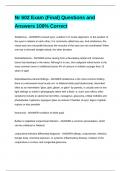Nr 602 Exam (Final) Questions and
Answers 100% Correct
Strabismus - ANSWER-crossed eyes; a defect in In ocular alignment, or the position of
the eyes in relation to each other; It is commonly called lazy eye. And strabismus, the
visual axes are not parallel because the muscles of the eyes are not coordinated; When
one eye is directed straight ahead, the other deviates
Retinoblastoma - ANSWER-tumor arising from a developing retinal cell; intraocular
tumor that develops in the retina. Although it is rare, this malignant retinal tumor is the
most common tumor in childhood (some 4% of cancers in children younger than 15
years of age)
Retinoblastoma clinical findings - ANSWER-strabismus is the most common finding
there is a decreased visual acuity uni- or bilateral white pupil (leukocoria), described
often as an intermittent "glow, glint, gleam, or glare" by parents, is usually seen in low
light settings or noted in photographs taken with a flash i.e. (cat's eye reflex); other
symptoms include an abnormal red reflex, nystagmus, glaucoma, orbital Cellulitis and
photophobia, hyphema, hypopyon (plus an anterior Chamber of eye); Signs of global
rupture or also possible
leukocoria - ANSWER-condition of white pupil
Bulbar or palpebral conjunctival infection - ANSWER-a common presentation, which
can be unilateral or bilateral
conjunctival infection differential diagnosis - ANSWER-allergy, conjunctivitis, infection,
foreign body, chemical exposure, or systemic inflammatory disease, irritation of the
conjunctiva or cornea, and congenital glaucoma.
,conjunctival infection drainage - ANSWER-watery discharge; purulent/mucoid discharge
ceftriaxone IM or IV. Chlamydia: - ANSWER-ophthalmia neonatorum management x/t
N. gonorrohea:
Erythromycin or possibly azithromycin PO - ANSWER-ophthalmia neonatorum
management d/t Chlamydia:
Antivirals IV or PO - ANSWER-Ophthalmia neonatorum management d/t HSV
Bacterial conjunctivitis - ANSWER-pinkeye; very contagious
watery discharge - ANSWER-can occur with allergies, nasolacrimal obstruction, foreign
bodies, viral infection, and iritis.
Purulent or mucoid discharge - ANSWER-noted with chronic dacrocystitis or
nasolacrimal obstruction.
Dacrocystitis - ANSWER-inflammation of the tear sac
Advanced allergic conjunctivitis - ANSWER-have some mucoid production.
To differentiate, microscopic investigation of discharge may lead to other clues
photophobia - ANSWER-sensitivity to light; symptom common of trauma and in infants
with glaucoma or retinal disease. Other non-eye related causes of this include
migraines and meningitis.
leukocoria - ANSWER-serious finding and demands immediate referral to the pediatric
ophthalmologist. white pupil
,causes of leukocoria - ANSWER-retinal detachment, cataract, retinal dysplasia,
retinopathy of prematurity, and in newborns retinoblastoma All newborns should have a
fundoscopic examination within 24 hours of birth and yearly on physical examinations.
ophthalmia neonatorum - ANSWER-conjunctivitis of the newborn. Etiology: chlamydia,
staphylococcus aureus, gonorrhea, HSV (silver nitrate reaction occurs on 10% of
neontes). Clinical findings: erythema, chemosis, purulent exudate with gonorrhea. Clear
to mucoid exudate with chlamydia. Diagnosis through gram stain to rule out gonorrhea
and chlamydia.
Chalazion - ANSWER-Benign, chronic lipogranulomatous inflammation of the eyelid
Risk of Chalazion - ANSWER-hordeolum or any condition which may impede flow
through the meibomian gland. Also mite species that reside in lash follicles
hordeolum (stye) - ANSWER-staph infection of a sebaceous gland in the eyelid. Most
commonly found at or near an eyelash follicle. Caused by bacterial infection either at
the root of the eyelash follicle or in the oil glands of the eyelid. Symptoms are
tenderness and swelling; treatment: spontaneous drainage and warm compresses
blepharitis - ANSWER-inflammation of the eyelid; Inflammation/infection of the lid
margins (chronic problem); can have flaking skin, excessive tearing, redness, irritation,
eyelash loss and/or crusty debris along the lash line
ophthalmia neonatorum management - ANSWER-saline irrigation to the eyes until
exudate is gone; follow with erythromycin ointment. N. gonorrohea: ceftriaxone IM or IV.
Chlamydia:
Bacterial conjunctivitis - ANSWER-in neonates 5-14 days, preschoolers, sexually active
teens: Haemphilus influenza (Most common organism), streptococcus pneumoniae, S.
Aureus, N. gonorrohea. Erythema, chemosis, itching, burning, mucopurulent exudate,
, matter in the eyelashes - worse in the morning, causing eyelashes to be shut; worse in
winter; Dx through cultures (required in neonates), r/o pharyngitis, AOM, URI, seborrhea
chemosis - ANSWER-edema of the conjunctiva
Bacterial conjunctivitis neonate treatment - ANSWER-Erythromycin 0.5% ophthalmic
ointment
Bacterial conjunctivitis >1 year treatment - ANSWER-fourth generation fluoroquinolone.
If concurrent AOM: treat accordingly for AOM. Warm soaks to eyes TID; don't share
towels or pillows; no school or work until treatment begins
Chronic Bacterial Conjunctivitis - ANSWER-Lasts more than 3 weeks and unresponsive
to treatment
Most common org is Staphylococcus Aureus. Gram negative orgs include:
-moraxella lacunata, serratia marcescens, ecoli, klebsiella pneumoniae, proteus.
Teens: Chlamydia
Erythema, chemosis, itching, burning, mucopurulwnt exudate, matter in the eyelashes;
foreign body; Dx by gram stain culture to r/o dacryostenosis, blepharitis, corneal ulcers,
trachoma
Chronic Bacterial Conjunctivitis treatment - ANSWER-depends on prior treatment, lab
results, and differential diagnosis. Review compliance of previous drug choices; consult
ophthalmologist
Inclusion conjunctivitis - ANSWER-occurs in neonates 5-14 days old and sexually active
teenagers: caused by : Chlamydia trachomatis; Erythema, chemosis, itching, burning,
mucopurulnt exudate or clear drainage, palpebral follicles. Cultures: ELISA, PCR r/o
sexual activity




